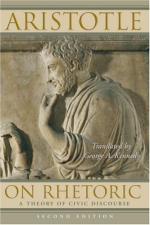|
This section contains 562 words (approx. 2 pages at 400 words per page) |

|
Book III, Chapters 13-19 Summary and Analysis
Chapter 13: There are two essential parts to a speech, the statement of the argument and the proof of the argument. As circumstances require, one might also add an introduction and epilogue, but for simple purposes these are excessive.
Chapter 14: The purpose of an introduction is to clarify the purpose of the speech. In some cases, an introduction is also useful for manipulating the prejudices of one's audience. Thus, for example, in a trial, the forensic orator, if he is defending a man accused of a crime, ought to try to make the jury or judges think favorably of his client; otherwise, their prejudices might skew their perception of the facts when the trial proceeds. However, a prosecutor should probably wait until the end of the case to try to prejudice the jury against the defendant...
(read more from the Book III, Chapters 13-19 Summary)
|
This section contains 562 words (approx. 2 pages at 400 words per page) |

|




